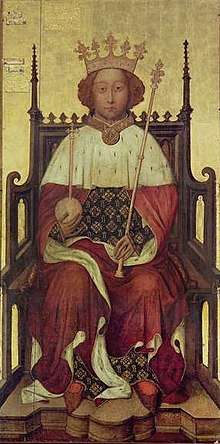College of Minor Canons
The Minor Canons of St Paul's Cathedral, London, whose origins predate the Norman conquest of England, unusually were independent of the senior canons and, as priests, of higher status than the lay vicars choral. Medieval Hereford furnishes the only other example of such a structure. The College of Minor Canons of St Paul's Cathedral, and the two historic titles "Senior Cardinal" and "Junior Cardinal", were abolished with effect from 1 February 2016.[1]
History

The College of Minor Canons (up to 12 in number) lived according to a Rule and from 1353 possessed a hall where they gathered daily for an evening meal. In 1378 the minor canons petitioned Pope Urban VI for a grant confirming their ‘ancient’ privileges, and in 1396 King Richard II authorised statutes to govern the college of minor canons at St Paul's.
The 1396 statutes (which probably reflected contemporary practice) provided for the election by the minor canons each June of a warden, who was to govern the college in association with his senior brethren, among them the Junior and Senior Cardinals. Whenever a vacancy arose in the college, the remaining members were to nominate two persons, from whom the dean and chapter made their selection. Prospective minor canons were to be "worthy, sufficient and meet men, not only in reading and singing, but also and especially in honesty of life and godliness of conversation". Upon election each new minor canon was to present the college with a silver spoon worth at least five shillings. To avoid scandal, canons were forbidden to bring women into the college precincts or to visit taverns in their company. Transgressors faced expulsion for a third offence. Hospitality was limited, for any legitimate guests at dinner were to pay a sum set by the warden "as the dearth or plenty of victuals then requires". Tranquillity was also important, for there was to be no noise in minor canons' residences after 9 pm. Sanitation was a constant concern, with a ha’penny fine for any minor canon who did "cast filth . . . [or] make water within the gates except it be in the place appointed for that purpose". These statutes of 1396 were confirmed by successive monarchs, as by Henry VII in 1487 and Elizabeth I in 1566. In 1840 an Act of Parliament, known as the St Paul's Cathedral Minor Canonries Act reduced the number of Minor Canons to six, with a Warden, and a Senior and Junior Cardinal among them. The College of Minor Canons of St Paul's Cathedral continued to exist until 2016, with three serving priests, as Chaplain (the role recently re-cast as Priest Vicar, not a Minor Canon), Sacrist and Succentor. Despite the abolition of the College of Minor Canons, St Paul's Cathedral retains two Minor Canons (Succentor and Sacrist) who take part in and organise services in the cathedral.
Cardinals

In the Church of England, the title Cardinal was, prior to the abolition of the College, applied to the two senior members of the College of Minor Canons of St Paul's Cathedral, who were known as the Senior and Junior Cardinal.[2] The use of the term predates the English Reformation and in 1898 a complete list of the Cardinals up to that time appeared in print.[3] The current minor canons are Rosemary Morton, Succentor and James Milne, Sacrist.. The Cardinal Rector of St Magnus-the-Martyr Church by London Bridge, is thought to be the only cleric entitled to use the title Cardinal in the Church of England.[2] Given that women are never made cardinals of the Roman church, women who served as Minor Canons of St Paul's and who were entitled to the "Cardinal" designation were the only women to be called cardinals.
History of the title
This usage of Cardinal dates back to before when the term assumed its present meaning as a high official of the Catholic Church. Originally, it could be applied to any priest permanently assigned or incardinated to a church. A papal grant of Urban VI (1378) referred to duo deputati ab antiquo, qui cardinales vocantur, the two who took a leading role in the affairs of the college. Their duties according to the statutes of the cathedral of 1396 were "continually to visit the sick and minister unto them as often as shall be needful".[2] The two Cardinals of the choir enjoyed fees from funerals and anniversary Masses sung in the cathedral.[4] They were consulted on liturgical matters, as on the suitability of the office hymn Verbum supernum at the time of the introduction of the Sarum Rite at St Paul's in the mid-fifteenth century. Their duty to celebrate at the high altar in place of the dean and canons was unique to St Paul's. Moreover, the junior Cardinal had special responsibility for visiting the sick and ministering the sacrament to them: a dangerous duty when the city was infected by plague and disease. In reward, the Cardinals enjoyed a double allowance of money, bread, and ale from the college common funds.[5] The Victorian poet Richard Harris Barham held one of these offices.[2]
References
- ↑ Constitution and Statutes of the Cathedral Church of St Paul in London as revised in the form annexed to the Instrument dated 1 February 2016 made by the Council of the Cathedral Church of St Paul in London established in accordance with the provisions of the Cathedrals Measure 1999 s 28, following consultation and public notice in accordance with ss 29 and 30 of the Measure and with the consent of the Bishop of London.
- 1 2 3 4 New Catholic Dictionary
- ↑ Hennessy, G. Novum Repertorium Ecclesiasticum Parochiale Londinense (1898).
- ↑ Secular canons: Cathedral of St. Paul, A History of the County of London: Volume 1: London within the Bars, Westminster and Southwark (1909), pp. 409-433. Date accessed: 5 December 2007.
- ↑ Reynolds, H. The Churches of the City of London London, The Bodley Head, 1922